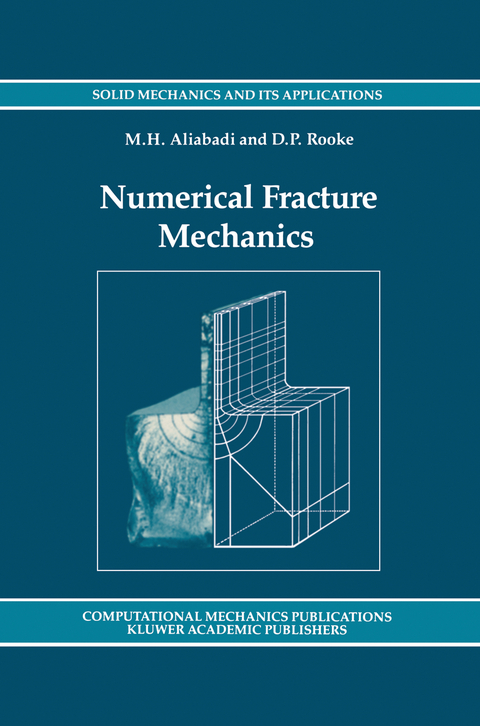
Numerical Fracture Mechanics
Springer (Verlag)
978-94-010-5485-0 (ISBN)
1. Basic Fracture Mechanics.- 1.1 Introduction.- 1.2 Energy balance.- 1.3 Stress intensity factors.- 1.4 Residual strength.- 1.5 Fatigue crack growth.- 1.6 Stress corrosion cracking.- 1.7 Limitations (plasticity).- 1.8 Residual stress effects.- 1.9 Concluding remarks.- 1.10 Bibliography.- 1.11 References.- 2. Development of Fracture Mechanics Analysis.- 2.1 Introduction.- 2.2 Basic equations of elasticity.- 2.3 Airy stress functions.- 2.4 Muskhelishvili’s complex functions.- 2.5 Complex stress function analysis.- 2.6 Westergaard’s stress function.- 2.7 William’s eigenfunction series expansion.- 2.8 Papkovich-Neuber potentials.- 2.9 The energy principle.- 2.10 Elastic-plastic fracture.- 2.11 Three-dimensional stress field.- 2.12 Mixed mode fracture.- 2.13 Concluding remarks.- 2.14 References.- 3. Numerical Methods in Linear Elastic Fracture Mechanics.- 3.1 Introduction.- 3.2 Superposition.- 3.3 Stress concentrations.- 3.4 Local stress distributions.- 3.5 Green’s functions/Weight functions.- 3.6 Compounding method.- 3.7 Boundary collocation methods.- 3.8 Integral transforms/continuous dislocations.- 3.9 Body force method.- 3.10 Method of lines.- 3.11 Edge function method.- 3.12 Finite element method.- 3.13 Alternating technique.- 3.14 Concluding remarks.- 3.15 References.- 4. The Boundary Element Method.- 4.1 Introduction.- 4.2 The boundary element formulation in elasticity.- 4.3 Fundamental solutions.- 4.4 Numerical discretization.- 4.5 Assembly of system of equations.- 4.6 Stress and displacement at interior points.- 4.7 Numerical evaluation of coefficient matrices.- 4.8 Evaluation of boundary stresses.- 4.9 Multi-domain formulation.- 4.10 Body force.- 4.11 Concluding remarks.- Appendix A Betti’s reciprocal theorem.- Appendix B Evaluation of the free term Cijfor smooth boundaries.- Appendix C Evaluation of local boundary stresses.- 4.12 References.- 5. Application of Boundary Element Methods to Fracture Mechanics.- 5.1 Introduction.- 5.2 Difficulties in crack modelling.- 5.3 Crack-tip elements.- 5.4 Crack Green’s function.- 5.5 Displacement discontinuity method.- 5.6 Energy method.- 5.7 J-integral.- 5.8 Subtraction of singularity.- 5.9 Concluding remarks.- 5.10 References.- 6. Weight Function Techniques.- 6.1 Introduction.- 6.2 Basic principles of Green’s functions.- 6.3 Stress intensity factors as Green’s functions.- 6.4 Systematic use of Green’s functions.- 6.5 Available Green’s functions.- 6.6 Weight functions.- 6.7 Numerical weight functions.- 6.8 Approximate weight functions.- 6.9 Application of the BEM to weight functions.- 6.10 Weight functions for strip yield cracks.- 6.11 Weight functions for residual stress fields.- 6.12 Concluding remarks.- Appendix A Closed form weight functions.- Appendix B Three-dimensional stress and displacement fields for a semi-infinite crack.- Appendix C Near-tip displacement and stress fields.- 6.13 References.
| Reihe/Serie | Solid Mechanics and Its Applications ; 8 |
|---|---|
| Zusatzinfo | X, 276 p. |
| Verlagsort | Dordrecht |
| Sprache | englisch |
| Maße | 155 x 235 mm |
| Themenwelt | Informatik ► Theorie / Studium ► Algorithmen |
| Mathematik / Informatik ► Mathematik ► Analysis | |
| Naturwissenschaften ► Physik / Astronomie ► Mechanik | |
| Technik | |
| ISBN-10 | 94-010-5485-1 / 9401054851 |
| ISBN-13 | 978-94-010-5485-0 / 9789401054850 |
| Zustand | Neuware |
| Haben Sie eine Frage zum Produkt? |
aus dem Bereich


